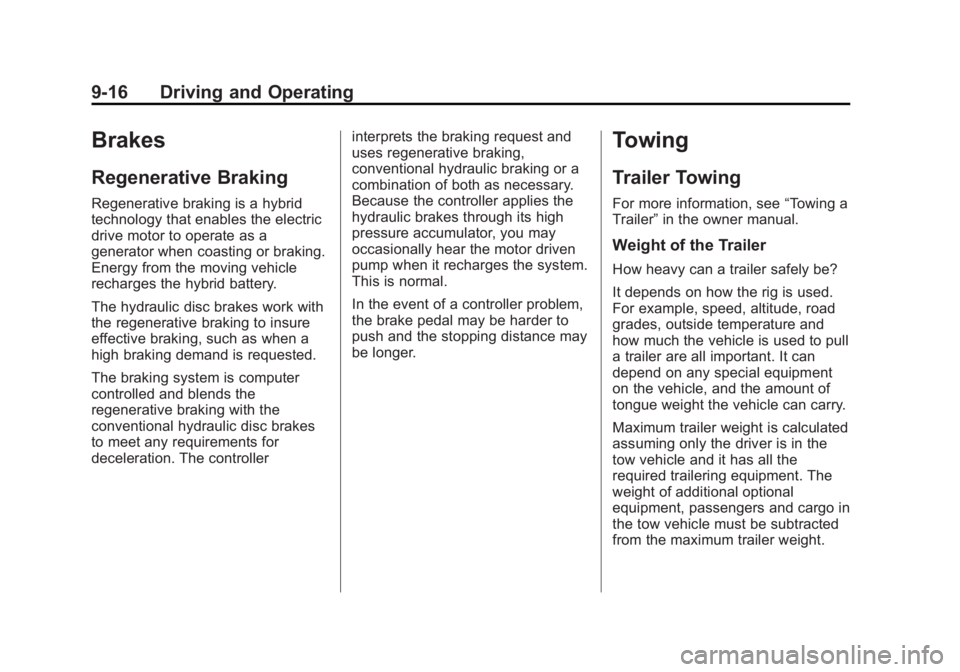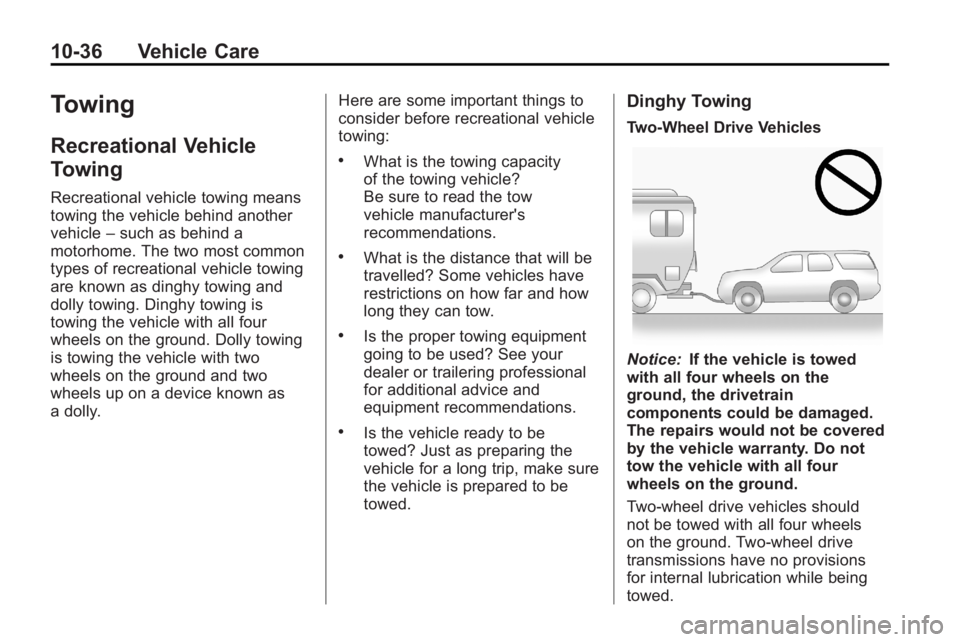Page 36 of 94

Black plate (10,1)Cadillac Escalade Hybrid - 2011
9-10 Driving and Operating
Manual Mode Range Selection Mode
The Range Selection Mode controls
the vehicle's transmission.
To use this feature:
1. Move the shift lever to the
M (Manual Mode).
2. Press the plus/minus button to
upshift or downshift selecting the
desired range of gears. A number displays next to the M,
indicating the current gear that has
been selected. The number
displayed in the gear indicator is the
highest gear that can be used. The
vehicle can automatically shift to
lower gears as it adjusts to driving
conditions. When 3 (Third) is
selected, 1 (First) through 3 (Third)
gears are automatically shifted by
the vehicle, but 4 (Fourth) cannot be
used until it is selected.
The Range Selection Mode controls
the vehicle and engine speed while
driving down a hill or towing a trailer,
by allowing you to select a desired
range of gears.
When you move the shift lever into
M, the transmission will default to
M4. In this gear range, effective
engine braking occurs at speeds
above 72 km/h (45 mph). Pushing the minus ( − ) button on the
shift lever reduces the gear range.
In the M3 gear range, effective
engine braking occurs at speeds
above 56 km/h (35 mph).
In the M2 gear range, effective
engine braking occurs at speeds
above 40 km/h (25 mph).
In the M1 gear range, effective
engine braking occurs at speeds
above 16 km/h (10 mph).
When operating in M (Manual
Mode), Auto Stop is disabled. For
better vehicle efficiency, operate the
vehicle in D (Drive) not
M (Manual Mode).
Cruise control can be used while
using the Range Selection Mode.
Page 42 of 94

Black plate (16,1)Cadillac Escalade Hybrid - 2011
9-16 Driving and Operating
Brakes Regenerative Braking Regenerative braking is a hybrid
technology that enables the electric
drive motor to operate as a
generator when coasting or braking.
Energy from the moving vehicle
recharges the hybrid battery.
The hydraulic disc brakes work with
the regenerative braking to insure
effective braking, such as when a
high braking demand is requested.
The braking system is computer
controlled and blends the
regenerative braking with the
conventional hydraulic disc brakes
to meet any requirements for
deceleration. The controller interprets the braking request and
uses regenerative braking,
conventional hydraulic braking or a
combination of both as necessary.
Because the controller applies the
hydraulic brakes through its high
pressure accumulator, you may
occasionally hear the motor driven
pump when it recharges the system.
This is normal.
In the event of a controller problem,
the brake pedal may be harder to
push and the stopping distance may
be longer. Towing Trailer Towing For more information, see “ Towing a
Trailer ” in the owner manual.
Weight of the Trailer How heavy can a trailer safely be?
It depends on how the rig is used.
For example, speed, altitude, road
grades, outside temperature and
how much the vehicle is used to pull
a trailer are all important. It can
depend on any special equipment
on the vehicle, and the amount of
tongue weight the vehicle can carry.
Maximum trailer weight is calculated
assuming only the driver is in the
tow vehicle and it has all the
required trailering equipment. The
weight of additional optional
equipment, passengers and cargo in
the tow vehicle must be subtracted
from the maximum trailer weight.
Page 43 of 94

Black plate (17,1)Cadillac Escalade Hybrid - 2011
Driving and Operating 9-17Use the following charts to determine how much the vehicle can weigh, based upon the vehicle model and options.
Vehicle Axle Ratio Maximum Trailer Weight GCWR*
2WD 6.0 L V8 3.08 2 631 kg (5,800 lbs) 5 443 kg (12,000 lbs)
4WD 6.0 L V8 3.08 2 540 kg (5,600 lbs) 5 443 kg (12,000 lbs)
*The Gross Combination Weight Rating (GCWR) is the total allowable weight of the completely loaded vehicle and
trailer including any passengers, cargo, equipment and conversions. The GCWR for the vehicle should not be
exceeded.
Towing Equipment Trailer Brakes If a trailer is being towed that has
trailer brakes and the trailer brakes
are manually applied while driving
slower than 40 km/h (25 mph), the
vehicle may go into auto stop mode
even if the brakes are not being
pressed. Using the trailer brake
system manually can make the
hybrid vehicle perform as if the
brake pedal in the vehicle is being
pressed. The trailer brake operation
check will still work. If the trailer
brakes are manually applied for an
extended period of time, the SERVICE BRAKE SYSTEM
message comes on in the Driver
Information Center. The message
goes off after the trailer brakes have
been released. No other action is
necessary. For more information,
see “ Towing Equipment ” in the
owner manual.
Page 80 of 94

10-36 Vehicle Care
Towing Recreational Vehicle
Towing Recreational vehicle towing means
towing the vehicle behind another
vehicle – such as behind a
motorhome. The two most common
types of recreational vehicle towing
are known as dinghy towing and
dolly towing. Dinghy towing is
towing the vehicle with all four
wheels on the ground. Dolly towing
is towing the vehicle with two
wheels on the ground and two
wheels up on a device known as
a dolly. Here are some important things to
consider before recreational vehicle
towing: .
What is the towing capacity
of the towing vehicle?
Be sure to read the tow
vehicle manufacturer's
recommendations. .
What is the distance that will be
travelled? Some vehicles have
restrictions on how far and how
long they can tow. .
Is the proper towing equipment
going to be used? See your
dealer or trailering professional
for additional advice and
equipment recommendations. .
Is the vehicle ready to be
towed? Just as preparing the
vehicle for a long trip, make sure
the vehicle is prepared to be
towed. Dinghy Towing Two-Wheel Drive Vehicles
Notice: If the vehicle is towed
with all four wheels on the
ground, the drivetrain
components could be damaged.
The repairs would not be covered
by the vehicle warranty. Do not
tow the vehicle with all four
wheels on the ground.
Two-wheel drive vehicles should
not be towed with all four wheels
on the ground. Two-wheel drive
transmissions have no provisions
for internal lubrication while being
towed.
Page 93 of 94

Black plate (3,1)Cadillac Escalade Hybrid - 2011
INDEX i-3
PPark
Shifting Into . . . . . . . . . . . . . . . . . . . . 9-5
Power
Steering Fluid . . . . . . . . . . . . . . . 10-13
RRear Storage . . . . . . . . . . . . . . . . . . . 4-1
Recommended Fluids and
Lubricants . . . . . . . . . . . . . . . . . . . . 11-2
Recreational Vehicle
Towing . . . . . . . . . . . . . . . . . . . . . . 10-36
Regenerative Braking . . . . . . . . . . 9-16
Replacement Parts
Airbags . . . . . . . . . . . . . . . . . . . . . . . . 3-1
Replacing Airbag System . . . . . . . 3-1
Rotation, Tires . . . . . . . . . . . . . . . . 10-22
Routing, Engine Drive Belt . . . . . 12-3
Running the Vehicle While
Parked . . . . . . . . . . . . . . . . . . . . . . . . 9-7 S Scheduled Maintenance . . . . . . . 11-1
Sealant Kit, Tire . . . . . . . . . . . . . . 10-24
Service
Doing Your Own Work . . . . . . . . 10-2
Vehicle Messages . . . . . . . . . . . . . 5-7
Shifting
Into Park . . . . . . . . . . . . . . . . . . . . . . . 9-5
Specifications and
Capacities . . . . . . . . . . . . . . . . . . . . 12-2
Starting the Vehicle . . . . . . . . . . . . . 9-2
Steering . . . . . . . . . . . . . . . . . . . . . . . . 9-1
Fluid, Power . . . . . . . . . . . . . . . . 10-13
Storage
Rear . . . . . . . . . . . . . . . . . . . . . . . . . . . 4-1
Storing the Tire Sealant
and Compressor Kit . . . . . . . . . 10-31
Supplement
Using . . . . . . . . . . . . . . . . . . . . . . . . . . . . iii T Tachometer . . . . . . . . . . . . . . . . . . . . . 5-3
Tires
If a Tire Goes Flat . . . . . . . . . . 10-23
Inflation Monitor System . . . . 10-18
Rotation . . . . . . . . . . . . . . . . . . . . 10-22
Sealant and
Compressor Kit . . . . . . . . . . . 10-24
Sealant and Compressor
Kit, Storing . . . . . . . . . . . . . . . . 10-31
Towing
Equipment . . . . . . . . . . . . . . . . . . . . 9-17
Recreational Vehicle . . . . . . . . 10-36
Trailer . . . . . . . . . . . . . . . . . . . . . . . . 9-16
Trailer Towing . . . . . . . . . . . . . . . . . 9-16
Transfer Case . . . . . . . . . . . . . . . . . 9-11
Transmission
Automatic . . . . . . . . . . . . . . . . . . . . . . 9-7
Fluid, Automatic . . . . . . . . . . . . . . 10-6
Messages . . . . . . . . . . . . . . . . . . . . . 5-7